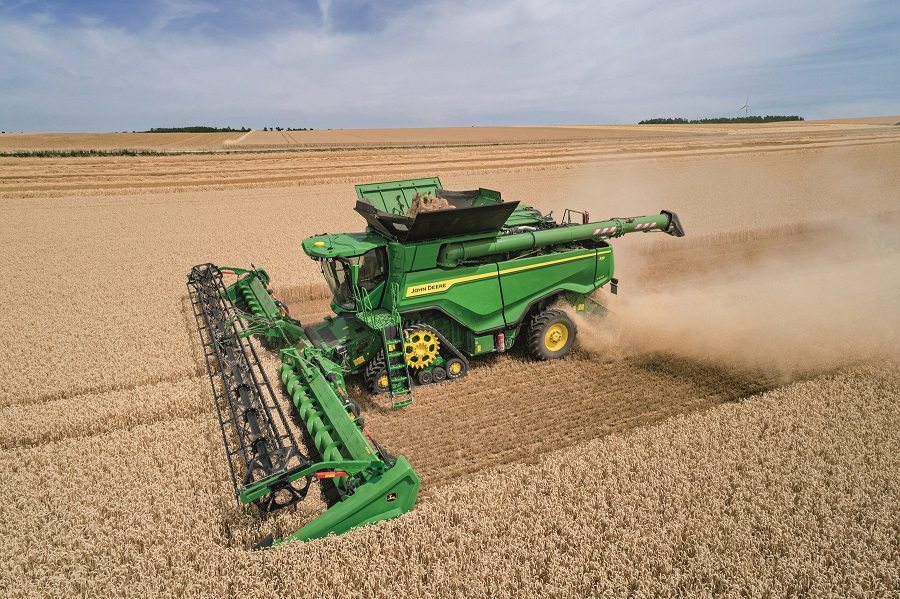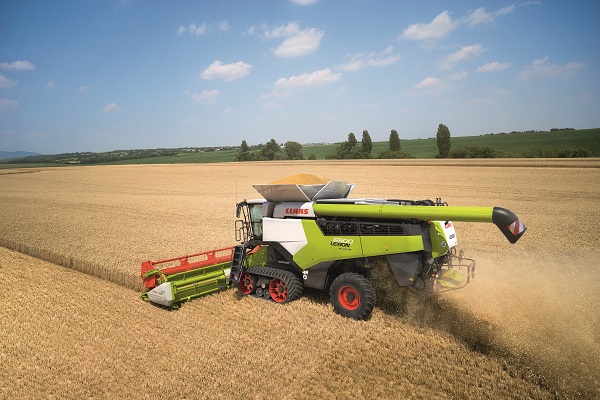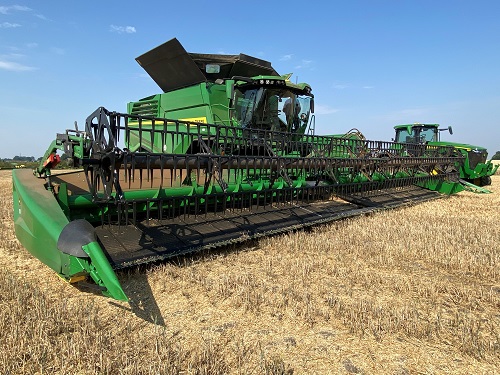 Getting more from less seems to be the recurring theme when it comes to combine harvester innovation at the moment. CPM checks out what’s new
Getting more from less seems to be the recurring theme when it comes to combine harvester innovation at the moment. CPM checks out what’s new
Our customers just get more: more productivity, more quality, more savings.
By Charlotte Cunningham
As this year’s harvest draws to a close for many, it brings the opportunity to reflect on what went well, or not – whether that be a particularly outstanding variety or the performance of the combine.
While harvest 2021 seems a lifetime away, planning potential investment in a new combine is not a decision that’s made overnight, and there are a number of different solutions and options available at present.
To help growers get a better handle on what’s new in the marketplace, CPM has rounded up some of the most recent launches to make their way onto the UK combine scene.
John Deere
2020 has been a perfect example of a season that requires a combine that has maximum capacity when it comes to tonnes/hour and ha/day.

John Deere has added two new X-series models to its 2021 harvesting line up – predominantly aimed at large-scale farmers battling narrower harvesting windows.
And it was this mindset exactly that led John Deere to develop and launch two new X-series models to add to its 2021 harvesting line up – predominantly aimed at large-scale farmers battling narrower harvesting windows.
According to Deere, the new X9 1000 and X9 1100 combines represent the next level of the firm’s harvesting performance and are now the flagship machines in John Deere’s range of harvesting solutions.
Looking at the figures, perhaps the most head-turning claim is the X9 1100’s ability to harvest 100t of wheat/hour – with less than 1% grain loss.
To put the claims to the test, CPM recently went to see it in action in Norfolk and can confirm it does indeed sit at this level pretty consistently.
“As conditions change, the X9 combine can make automatic adjustments for the operator so it consistently operates at peak levels,” says John Deere product marketing manager Jonathan Edwards.
At the core of this improved performance that comes with the new models, is the feederhouse, which is claimed to be the widest on the market. Coupled with a new dual rotary separator – and what Deere claim to be the industry’s largest cleaning shoe – these work together to improve crop flow and increase harvesting capacity, adds Jonathan.
“The crop transitions from the feederhouse and is fed very evenly by the chevron-design feed accelerator towards the heart of the new combine – the X-Series Dual Separator (XDS).
“With the largest active threshing and separation areas we have ever offered, crop in the XDS is handled through nine revolutions, resulting in low losses and increased harvesting capacity.”
The 3.51m long XDS rotors have taken the proven modular concept from the S-Series combines, with dedicated sections for threshing and separation. Alongside the traditional threshing elements, the separation area utilises a finger design to tease the last grains from the crop mat, in turn enhancing performance in conditions that are less than ideal, he adds.
Looking at the capacity of the new launches, the X9 1000 grain tank holds 14,800 litres and the X9 1100 up to 16,200 litres of grain, with unloading rates of up to 186 litres/sec.
Turning focus to the cleaning shoe, at 7m2 its cleaning area is 36% greater than seen in Deere’s S-Series, as well as 45% more cleaning capacity as a result of a new fan system – again, in comparison with the S-Series.
“This enables the highest grain quality on the market and once more underlines that these new combines are clearly positioned above any previous combine offering, addressing the needs of the largest and most demanding customers across Europe,” says Jonathan.
In the guts of the combine is a new 13.6 litre six-cylinder engine, capable of delivering up to 700hp, that ensures maximum uptime by being able to run for 14 hours without needing to refuel.
Having proved to be a successful addition to Deere’s 9000 Series foragers, the X9 also features HarvestMotion – a belt drive system which is claimed to deliver 20% lower fuel consumption, 30% more torque, and lower engine rpm to make running the new models as cost efficient as possible.
For those looking for cab comfort, the X9 models also feature a number of options including a seat fitted with a massage function, Apple CarPlay, and an updated LED lighting package.

Claas has also added to the market with its second generation Lexion 6000 and 5000 range of straw walker combines, which have been introduced in the UK this summer.
With GPS thefts having become somewhat of a problem over recent years, Deere has tackled the problem head on, and the StarFire GPS guidance system now comes as a standard, built-in feature on the new launches in a bid to alleviate the issues.
JDLink is also available free of charge on both models for two years, adds Jonathan. “This enables machine-to-machine communication and makes it easy for the owner and operator to send field and agronomic data to and from the machine, as well as share machine performance information. With John Deere Connected Support, owners also get unmatched dealer service through Expert Alerts – an industry exclusive – where potential downtime is detected and resolved before it happens.”
New Holland
New in yellow and blue is the CH7.70 from New Holland that combines twin rotor separation with threshing technology to offer greater flexibility to customers, as part of the firms new Crossover Harvesting concept.
According to the firm, the Crossover Combine sets a new benchmark in capacity for mid-range combines, delivering optimum grain and straw quality – but what exactly does this new concept mean in practical terms?
The new Crossover technology delivers up to 25% higher throughput than a conventional combine in this segment. The two-drum threshing system features a 600mm diameter drum – the largest in the segment – with a reinforced, heavy-duty build, designed to deliver a high standard of threshing performance. The large drum combined with the user-friendly sectional concave, offers the best match in terms of versatility, enabling fast adaptation to different crops, in less than 20 mins, adds the firm.
Drum speed is controlled from the cab by a new heavy-duty hydraulic drum variator, so that the operator can easily ensure the speed is perfectly matched to the crop and field conditions. The threshing system is combined with the New Holland Opti-Thresh system, which adapts to crop conditions and maturity simply by repositioning the rear part of the concave, meaning no tools are needed.
The CH7.70 combines this high-capacity two-drum system with the firm’s twin rotor concept to deliver the Crossover Harvesting experience.
“The new Crossover combine creates a new segment in New Holland’s wide offering, between mid-range conventional and flagship rotary models, further extending the choice of solutions for our customers, capable of meeting the specific needs of all types of farming operations,” says Lionel Gleyroux, combines and New Holland flagship Europe. “The new Crossover Harvesting concept takes the best of our harvesting expertise to create the opportunity for every farmer and contractor to be more productive, versatile and effective. It offers the best of both worlds – New Holland’s best twin rotor and conventional technologies – to deliver segment-leading performance throughput.”
“With the new Crossover Harvesting concept, our customers just get more: more productivity, more quality, more savings.”
At the heart of the launch is the Cursor 9 engine that develops 374hp – 34hp more than the CX6.90.
The CH combine has also been designed to deliver easy maintenance, with only four greasing points making daily maintenance even quicker and the large service door on top of the straw hood door provides easy access. This maintenance-free after-treatment system, together with the low fuel consumption, results in extremely low operating costs, says the firm.
In addition, the standard three-year extended warranty (1200 engine hours) covering the engine, driveline, and after-treatment system, together with the long, 600-hour service intervals, further contributes to the combine’s low operating costs.
In terms of cleaning capacity, the CH7.70 features the firm’s new Triple-Clean system which is said to boost cleaning capacity by up to 15% – with the addition of an extra cascade in the centre of the grain pan. The double flight cross auger, which transfers grain to the elevator faster, can result in an increase in throughput, improving capacity further.
For those working on uneven ground, the CH7.70 also boasts New Holland’s SmartSieve system, which automatically compensates for side slopes up to 25%, maintaining optimum sieve balance for uniform cleaning.
The system also calibrates sieve action based on fan speed and kernel size to determine the optimal throwing angle. In addition, the Opti-Fan system automatically allows for fluctuating grain speed across the cleaning shoe when the machine is working on slopes. It reduces fan speed when travelling uphill so no grain is lost out the back of the combine and increases it when moving downhill to prevent clogging of the shoe.
Header options
John Deere has expanded its header line-up for combine harvesters to include the brand-new HD Hinged Drapers range and the new HydraFlex Drapers.
Each is compatible with the new John Deere X-Series and most S-Series, T-Series and W-Series combines, to help achieve maximum harvesting capacity while minimising grain losses in a wide range of crops and conditions, says the firm.
According to Deere, HDX (Hinged Draper EXtended Table) Drapers are ideal for small grains and oilseed rape growers who want to maximise their combine’s performance across various crops, changing conditions and uneven or rolling terrain while capturing more grain. “The HDX has a new hinged frame that provides unmatched terrain-following capability with twice the wing range of a MacDon FD1 FlexDraper, with uniform cut height when harvesting on undulating or uneven terrain,” says Jonathan. “The HDX provides wing tip travel of up to 300cm and features an extra deep belt design of 1200mm, 12% more than the nearest competitor.”
Designed specifically for European customers, these easy-to-use drapers effectively pick up and sweep the down or lodged crop across the cutterbar to recover more of the crop, thanks to a consistent distance between the reel fingers and cutterbar, an increased reel range and higher reel drive motor torque, he explains. “Up until now customers have had to compromise between draper-feeding technology and overall performance in oilseed rape. The HDX is the first draper we have ever tested in rapeseed that would outperform an auger header in terms of rated capacity and maximum throughput.”
HDX Drapers are fitted with patented John Deere grain-saver draper belts as standard. Together with the fingered top augers, these belts are claimed to be able to reduce oilseed rape cutterbar and pod shatter loss by up to 25% when compared with traditional draper systems.
Also new is the RDF (Rigid Draper Flex Knife) HydraFlex Drapers which are based on the cutting technology of the existing 700FD model, as well as boasting a few new features to reduce grain loss.
All RDF HydraFlex Drapers feature a new two-speed centre feed section that allows operators to slow down the feed drum and centre feed belt by 20%, notes Jonathan. “This puts more grain in the tank by reducing free grain loss – operators can easily go from high to low speed to save easy shelling crops such as soybeans. Two centre feed belt options are available as standard equipment to optimise the RDF HydraFlex Draper for multiple crops and conditions.”
Mid-sized options from Case IH
The end of last year saw Case IH announce that a new three-model range of Axial-Flow combines would replace the existing 140 series for 2020.
The main changes on the new 150 series are an upgraded engine, – to meet Stage V emission regulations – improved tyres to minimise ground pressure and compaction issues, as well as an all-new LED lighting package with long distance and row finder lights, designed to ensure safer harvesting and improved manoeuvring on headlands.
“Case IH remains unique in our focus solely on a single rotor design with no prior drum and concave, because we believe the simplicity of this configuration to be the best way to achieve reliable, high-output, low-cost harvesting – and with minimal time needed to adjust the machine from crop to crop, that achievement is unaffected by the number of different crop types a business may be cutting,” says August von Eckardstein, Case IH Europe harvesting product marketing manager.




